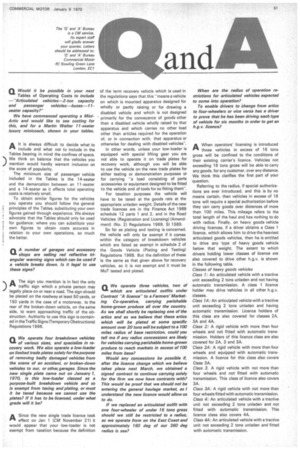a We operate three vehicles, two of which are articulated outfits
Page 57

If you've noticed an error in this article please click here to report it so we can fix it.
under Contract 'A licence" to a Farmers' Marketing Co-operative, carrying perishable home-grown produce all over the country. As we shall shortly be replacing one of the artics and as we believe that these artics which will be plated at some specific amount over 20 tons will be subject to a 100 miles radius of base restriction, could you tell me if any radius concessions are likely for vehicles carrying perishable home-grown produce to reach markets in excess of 100 miles from base?
Would any concessions be possible after the licence change which we believe takes place next March, we obtained a signed contract to continue carrying solely for the firm we now have contracts with? This would be proof that we should not be entering the general haulage market, as I understand the new licence would allow us to do.
If we replaced an articulated outfit with one four-wheeler of under 16 tons gross should we still be restricted to a radius, as we operate from on the East Coast and approximately 160 deg of our 360 deg radius is sea? When are the radius of operation restrictions for articulated vehicles expected to come into operation?
To enable drivers to Change from artics to four-wheelers or vice versa has a driver to prove that he has been driving each type of vehicle for six months in order to get an h.g.v. licence?
A When operators' licensing is introduced rs those vehicles in excess of 16 tons gross will be confined to the conditions of their existing carrier's licence. Vehicles not exceeding 16 tons gross will be able to carry any goods, for any customer, over any distance. We think this clarifies the first part of your question.
Referring to the radius, if special authorizations are ever introduced, and this is by no means certain, then vehicles in excess of 16 tons will require a special authorization before they can carry goods over distances of more than 100 miles. This mileage refers to the total length of the haul and has nothing to do with radius. Finally, on heavy goods vehicle driving licences, if a driver obtains a Class 1 licence, which allows him to drive the heaviest articulated goods vehicles, then he is entitled to drive any type of heavy goods vehicle below that weight. The extent to which drivers holding lower classes of licence are also covered to drive other h.g.v. is shown in the following table.
Classes of heavy goods vehicles Class 1: An articulated vehicle with a tractive unit exceeding 2 tons unladen and not having automatic transmission. A class 1 licence holder may drive vehicles in all other h.g.v. classes.
Class 1A: An articulated vehicle with a tractive unit exceeding 2 tons unladen and having automatic transmission. Licence holders of this class are also covered for classes 2A, 3A and 4A.
Class 2: A rigid vehicle with more than four wheels and not fitted with automatic transmission. Holders of this licence class are also covered for 2A, 3 and 3A.
Class 2,1: A rigid vehicle with more than four wheels and equipped with automatic transmission. A licence for this class also covers Class 3A.
Class 3. A rigid vehicle with not more than four wheels and not fitted with automatic transmission. This class of licence also covers 3A.
Class 3A: A rigid vehicle with not more than four wheels fitted with automatic transmission. Class 4: An articulated vehicle with a tractive unit not exceeding 2 tons unladen and not fitted with automatic transmission. This licence class also covers 4A.
Class 4A: An articulated vehicle with a tractive unit not exceeding 2 tons unladen and fitted with automatic transmission.








































































































